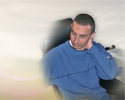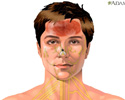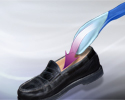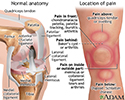Back pain - when you see the doctor
When you first see your health care provider for back pain, you will be asked about your back pain, including how often and when it occurs and how severe it is. Your provider will try to determine the cause of your pain and whether it is likely to quickly get better with simple measures, such as ice, mild painkillers, physical therapy, and...
The Basics
A Closer Look
Neck pain - Animation
Neck pain
Animation
Feeling pain - Animation
Feeling pain
Animation
Heel pain - Animation
Heel pain
Animation
Knee pain
The location of knee pain can help identify the problem. Pain on the front of the knee can be due to bursitis, arthritis, or softening of the patella cartilage as in chondromalacia patella. Pain on the sides of the knee is commonly related to injuries to the collateral ligaments, arthritis, or tears to the meniscuses. Pain in the back of the knee can be caused by arthritis or cysts, known as Baker's cysts. Baker's cysts are an accumulation of joint fluid (synovial fluid) that forms behind the knee. Overall knee pain can be due to bursitis, arthritis, tears in the ligaments, osteoarthritis of the joint, or infection.
Knee pain
illustration
Neck pain - Animation
Neck pain
Animation
Feeling pain - Animation
Feeling pain
Animation
Heel pain - Animation
Heel pain
Animation
Knee pain
The location of knee pain can help identify the problem. Pain on the front of the knee can be due to bursitis, arthritis, or softening of the patella cartilage as in chondromalacia patella. Pain on the sides of the knee is commonly related to injuries to the collateral ligaments, arthritis, or tears to the meniscuses. Pain in the back of the knee can be caused by arthritis or cysts, known as Baker's cysts. Baker's cysts are an accumulation of joint fluid (synovial fluid) that forms behind the knee. Overall knee pain can be due to bursitis, arthritis, tears in the ligaments, osteoarthritis of the joint, or infection.
Knee pain
illustration
Back pain - when you see the doctor
When you first see your health care provider for back pain, you will be asked about your back pain, including how often and when it occurs and how severe it is. Your provider will try to determine the cause of your pain and whether it is likely to quickly get better with simple measures, such as ice, mild painkillers, physical therapy, and...
The Basics
A Closer Look
Back pain - when you see the doctor
When you first see your health care provider for back pain, you will be asked about your back pain, including how often and when it occurs and how severe it is. Your provider will try to determine the cause of your pain and whether it is likely to quickly get better with simple measures, such as ice, mild painkillers, physical therapy, and...
The Basics
A Closer Look
Review Date: 8/12/2023
Reviewed By: C. Benjamin Ma, MD, Professor, Chief, Sports Medicine and Shoulder Service, UCSF Department of Orthopaedic Surgery, San Francisco, CA. Also reviewed by David C. Dugdale, MD, Medical Director, Brenda Conaway, Editorial Director, and the A.D.A.M. Editorial team.




